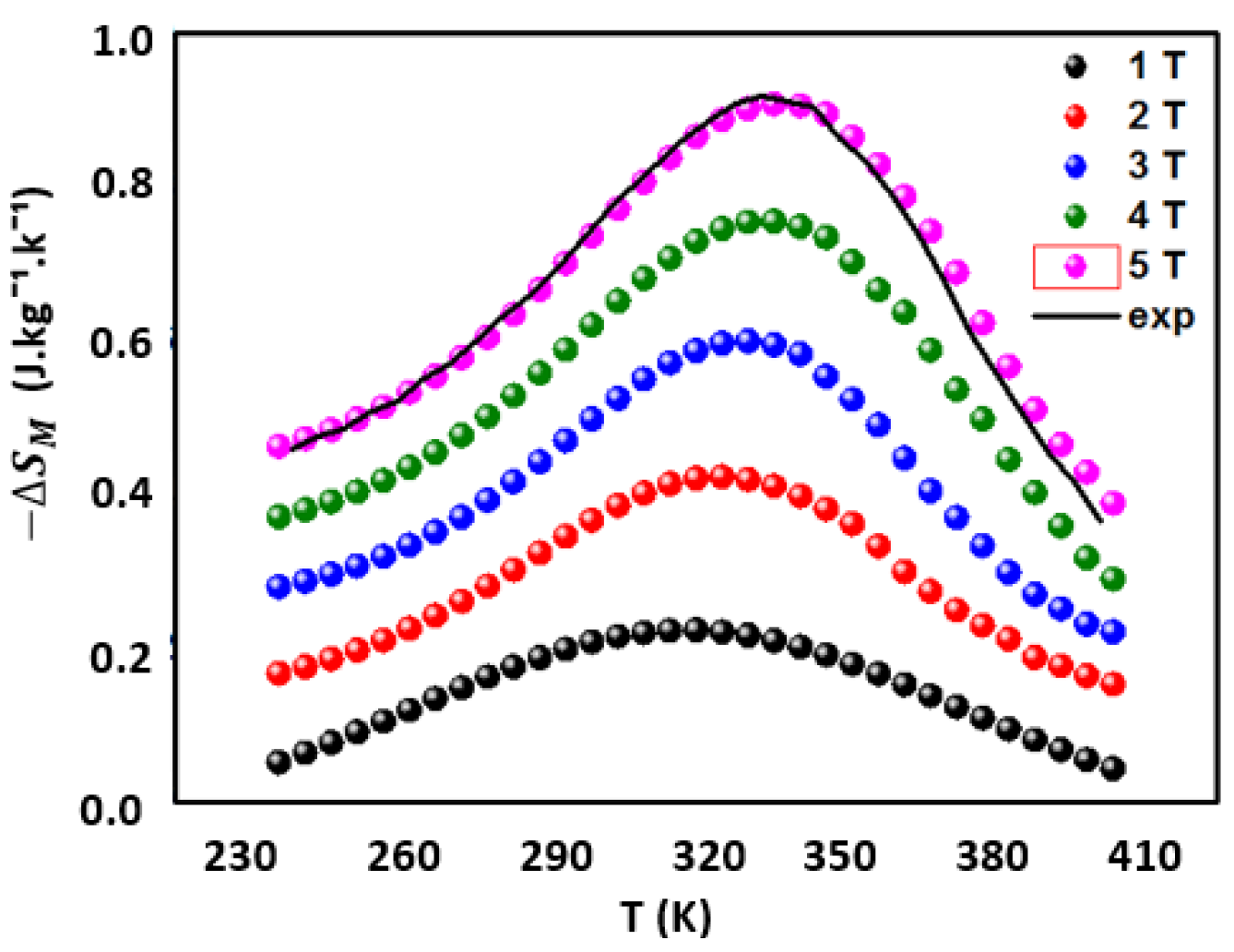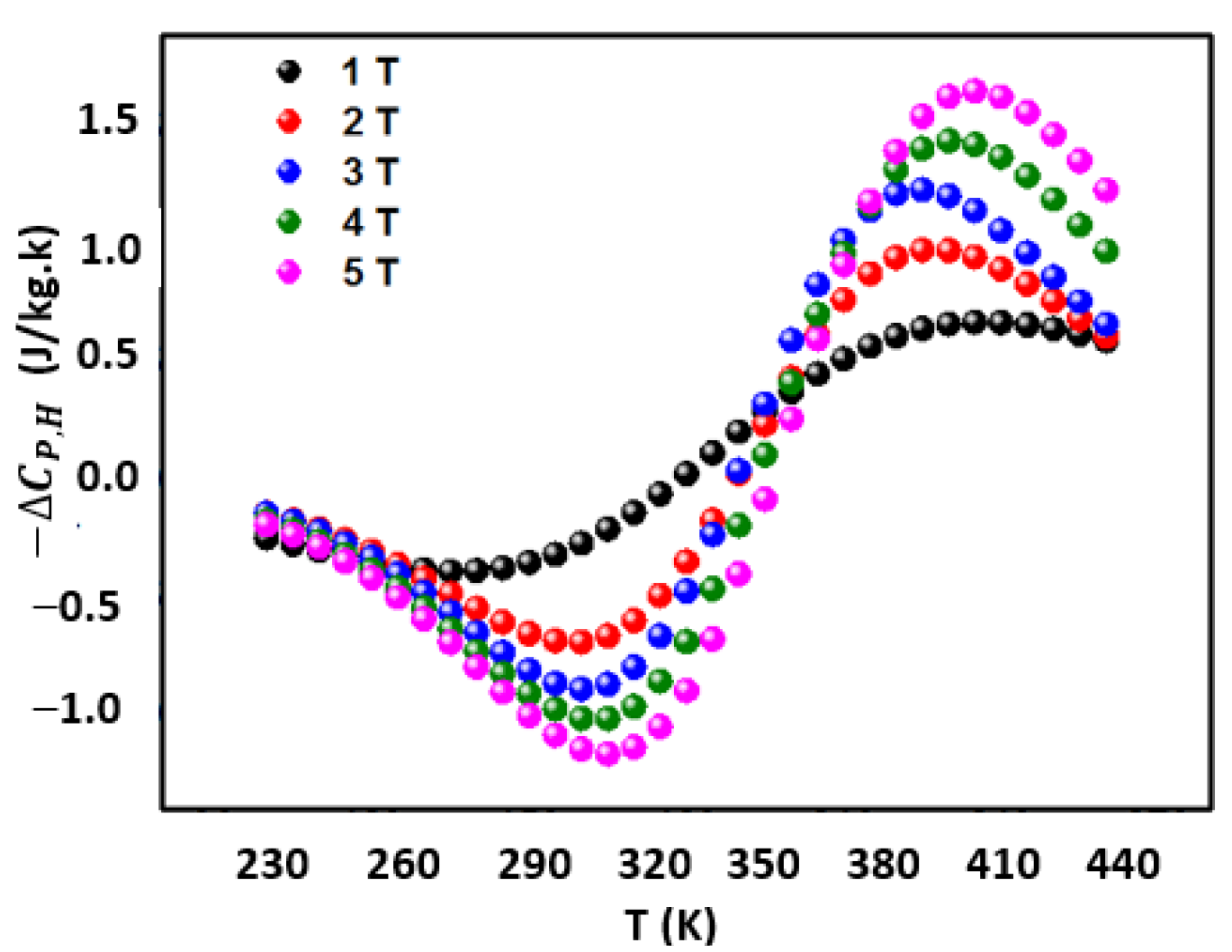Prediction of the Magnetocaloric Effect of Ni42Mn46CoSn11 Heusler Alloy with a Phenomenological Model †
Abstract
1. Introduction
2. Materials and Methods
3. Results
3.1. Structure and Microstructure
3.2. Magnetocaloric Effect Modeling: Landau Theory
3.3. Prediction of Magnetocaloric Effect: Phenomenological Model
4. Conclusions
Author Contributions
Funding
Institutional Review Board Statement
Informed Consent Statement
Data Availability Statement
Acknowledgments
Conflicts of Interest
References
- Sutou, Y.; Imano, Y.; Koeda, N.; Omori, T.; Kainuma, R.; Ishida, K.; Oikawa, K. Magnetic and martensitic transformations of NiMnX (X = In, Sn, Sb) ferromagnetic shape memory alloys. Appl. Phys. Lett. 2004, 85, 4358–4360. [Google Scholar] [CrossRef]
- Krenke, T.; Acet, M.; Wassermann, E.F.; Moya, X.; Maňosa, L.; Planes, A. Ferromagnetism in the austenitic and martensitic states of Ni-Mn-In alloys. Phys. Rev. B 2006, 73, 174413. [Google Scholar] [CrossRef]
- Krenke, T.; Acet, M.; Wassermann, E.F.; Moya, X.; Maňosa, L.; Planes, A. Martensitic transitions and the nature of ferromagnetism in the austenitic and martensitic states of Ni-Mn-Sn alloys. Phys. Rev. B 2005, 72, 014412. [Google Scholar] [CrossRef]
- Khan, M.; Pathak, A.K.; Paudel, M.R.; Dubenko, I.; Stadler, S.; Ali, N. Magnetoresistance and field-induced structural transitions in Ni50Mn50-xSnx Heusler alloys. J. Magn. Magn. Mater. 2008, 320, L21–L25. [Google Scholar] [CrossRef]
- Hernando, B.; Sánchez-Llamazares, J.L.; Santos, J.D.; Sánchez, M.L.; Escoda, L.; Suňol, J.J.; Varga, R.; Garcia, C.; González, J. Grain-oriented NiMnSn and NiMnIn Heusler alloys ribbons produced by melt-spinning: Martensitic transformation and magnetic properties. J. Magn. Magn. Mater. 2009, 321, 763–768. [Google Scholar] [CrossRef]
- Santos, J.D.; Sánchez, T.; Alvarez, P.; Sánchez, M.L.; Sánchez-Llamazares, J.L.; Hernando, B.; Escoda, L.; Suňol, J.J.; Varga, R. Microstructure and magnetic properties of Ni50Mn37Sn13 Heusler alloy ribbons. J. Appl. Phys. 2008, 103, 07B326. [Google Scholar] [CrossRef]
- Aksoy, S.; Acet, M.; Deen, P.P.; Maňosa, L.; Planes, A. Magnetic correlations in martensitic Ni-Mn-Based Heusler shape memory alloys: Neutron polarization analysis. Phys. Rev. B 2009, 79, 212401. [Google Scholar] [CrossRef]
- Planes, A.; Maňosa, L.; Acet, M. Magnetocaloric effect and its relation to shape memory properties in ferromagnetic Heusler alloys. J. Phys. Cond. Matter 2009, 21, 233201. [Google Scholar] [CrossRef] [PubMed]
- Liu, J.; Scheerbaum, N.; Lyubina, J.; Gutfleisch, O. Reversibility of magnetostructural transition and associated magnetocaloric effect in Ni-Mn-In-Co. Appl. Phys. Lett. 2008, 93, 102512. [Google Scholar] [CrossRef]
- Xuan, H.C.; Cao, Q.Q.; Zhang, C.I.; Ma, S.C.; Chen, S.Y.; Wang, D.H.; Du, Y.W. Large exchange bias field in Ni-Mn-Sn Heusler alloys with high content of Mn. Appl. Phys. Lett. 2010, 96, 202502. [Google Scholar] [CrossRef]
- Huang, L.; Cong, D.Y.; Ma, L.; Nie, Z.H.; Wang, Z.L.; Suo, H.L.; Ren, Y.; Wang, Y.D. Large magnetic entropy change and magnetoresistance in a Ni41Co9Mn40Sn10 magnetic shape memory alloy. J. Alloys Compd. 2015, 647, 1081–1085. [Google Scholar] [CrossRef]
- Elphick, K.; Frost, W.; Samiepour, M.; Kubota, T.; Takanashi, K.; Sukegawa, H.; Miani, S.; Hirohata, A. Heusler alloys for spintronic devices: Review on recent development and future perspectives. Sci. Technol. Adv. Mater. 2021, 22, 235–271. [Google Scholar] [CrossRef] [PubMed]
- Sun, H.; Jing, C.; Zeng, H.; Su, Y.; Yang, S.; Zhang, Y.; Bachaga, T.; Zhou, T.; Hou, L.; Ren, W. Martensitic transformation, magnetic and mechanical characterstics in unidirectional Ni-Mn-Sn Heusler alloy. Magnetochemistry 2022, 8, 136. [Google Scholar] [CrossRef]
- Cong, D.Y.; Roth, S.; Schultz, L. Magnetic properties and structural transformations in Ni-Co-Mn-Sn multifunctional alloys. Acta Mater. 2012, 60, 5335–5351. [Google Scholar] [CrossRef]
- Zhang, W.Y.; Skomski, R.; Valloppilly, S.R.; Khatri, Y.; Kashyap, A.; Sellmyer, D.J. Magnetism and structure of Fe- and Co-substituted Mn2NiSn. J. Magn. Magn. Mater. 2021, 537, 168157. [Google Scholar] [CrossRef]
- Hamad, M.A. Prediction of thermomagnetic properties of La0.67Ca0.33MnO3 and La0.67Sr0.33MnO3. Phase Trans. 2012, 85, 106–112. [Google Scholar] [CrossRef]
- Lutterotti, L.; Matthies, S.; Wenk, H.R. MAUD: A friendly Java program for material analysis using diffraction. CPD Newsletter 1999, 21, 14–15. [Google Scholar]
- Amaral, V.S.; Amaral, J.S. Magnetoelastic coupling influence on the magnetocaloric effect in ferromagnetic materials. J. Magn. Magn. Mater. 2004, 272–276, 2104–2105. [Google Scholar] [CrossRef]
- Landau, L.D.; Lifshitz, E.M. Statistical physics, Part 2. In Course of Theoretical Physics; P.I. Library: Oxford, UK; M.C. Robert Maxwell: New York, NY, USA, 1958. [Google Scholar]






| µ0H (T) | Mi (emu/g) | Mf (emu/g) | TC (K) | A (K−1) | B (emu/gK) | SC (emu/gK) |
|---|---|---|---|---|---|---|
| 1 | 37.5536 | 1.0520 | 331.07 | 0.0131 | −0.0482 | −0.2198 |
| 2 | 25.3502 | 7.8995 | 339.18 | 0.0190 | −0.0622 | −0.2091 |
| 3 | 22.9066 | 11.0964 | 343.86 | 0.0216 | −0.0823 | −0.1978 |
| 4 | 23.0751 | 12.3441 | 347.91 | 0.0195 | −0.0817 | −0.1859 |
| 5 | 24.4584 | 12.6313 | 350.20 | 0.0189 | −0.0828 | −0.1792 |
| µ0H (T) | ΔSM,max (J/kgK) | δTFWHM (K) | RCP (J/kg) | ΔCP,H, min (J/kgK) | ΔCP,H, max (J/kgK) |
|---|---|---|---|---|---|
| 1 | 0.3051 | 36.6751 | 10.1840 | −0.3779 | 0.6891 |
| 2 | 0.4536 | 34.3471 | 13.7305 | −0.6768 | 0.9884 |
| 3 | 0.6603 | 63.2849 | 36.7886 | −0.8548 | 1.2253 |
| 4 | 0.7967 | 92.3566 | 68.3692 | −1.0371 | 1.4389 |
| 5 | 0.9689 | 156.5735 | 129.3906 | −1.1753 | 1.6761 |
Disclaimer/Publisher’s Note: The statements, opinions and data contained in all publications are solely those of the individual author(s) and contributor(s) and not of MDPI and/or the editor(s). MDPI and/or the editor(s) disclaim responsibility for any injury to people or property resulting from any ideas, methods, instructions or products referred to in the content. |
© 2025 by the authors. Licensee MDPI, Basel, Switzerland. This article is an open access article distributed under the terms and conditions of the Creative Commons Attribution (CC BY) license (https://creativecommons.org/licenses/by/4.0/).
Share and Cite
Dadda, K.; Ghouari, L.; Elmohri, A.; Debili, M.Y.; Hlil, E.-K. Prediction of the Magnetocaloric Effect of Ni42Mn46CoSn11 Heusler Alloy with a Phenomenological Model. Mater. Proc. 2025, 25, 4. https://doi.org/10.3390/materproc2025025004
Dadda K, Ghouari L, Elmohri A, Debili MY, Hlil E-K. Prediction of the Magnetocaloric Effect of Ni42Mn46CoSn11 Heusler Alloy with a Phenomenological Model. Materials Proceedings. 2025; 25(1):4. https://doi.org/10.3390/materproc2025025004
Chicago/Turabian StyleDadda, Karima, Lahcene Ghouari, Abdennour Elmohri, Mohamed Yacine Debili, and El-Kebir Hlil. 2025. "Prediction of the Magnetocaloric Effect of Ni42Mn46CoSn11 Heusler Alloy with a Phenomenological Model" Materials Proceedings 25, no. 1: 4. https://doi.org/10.3390/materproc2025025004
APA StyleDadda, K., Ghouari, L., Elmohri, A., Debili, M. Y., & Hlil, E.-K. (2025). Prediction of the Magnetocaloric Effect of Ni42Mn46CoSn11 Heusler Alloy with a Phenomenological Model. Materials Proceedings, 25(1), 4. https://doi.org/10.3390/materproc2025025004





